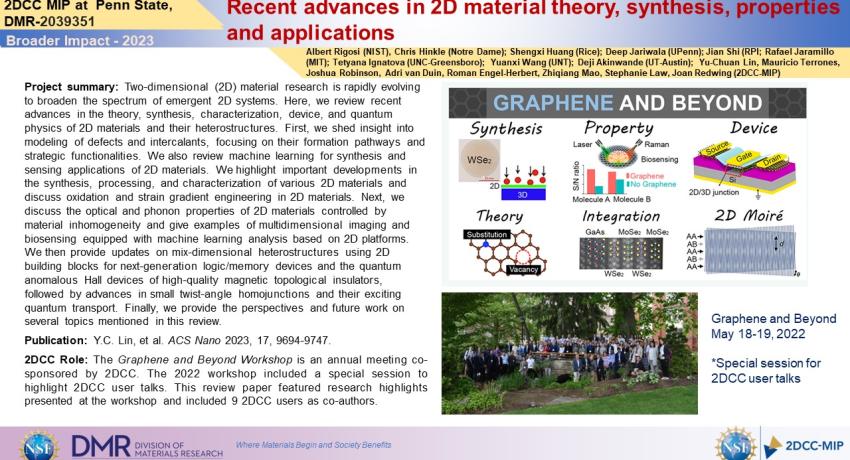What Has Been Achieved: A review article was published in ACS Nano highlighting advances in the theory, synthesis, properties and applications of 2D materials.
Importance of Achievement: The review article highlights rapidly evolving research in 2D materials that was presented at the 2022 Graphene and Beyond Workshop.
Unique Features of the MIP That Enabled Project:. The Graphene and Beyond Workshop is an annual meeting co-sponsored by 2DCC. The 2022 workshop included a special session to highlight 2DCC user talks. This review paper featured research highlights presented at the workshop and included 7 2DCC users as co-authors.
Publication: Y.C. Lin, et al. ACS Nano 2023, 17, 9694-9747 https://doi.org/10.1021/acsnano.2c12759.
Acknowledgments: Y.-C.L., R.T., R.Y., C.L.H., and J.A.R. acknowledge funding from NEWLIMITS, a center in nCORE, a Semiconductor Research
Corporation (SRC) program sponsored by NIST through award number 70NANB17H041. Y.-C.L. also appreciates the support from the Department of Materials Science and Engineering at NYCU. R.Y. and C.L.H. were also supported by the SRC through the Global Research Collaboration (GRC) Program. This work was also supported in part by the National Science Foundation (NSF) through the Division of Materials Research (DMR) award number 1921818. Work presented herein was performed, for a subset of the authors (A.F.R and H.M.H.), as part of their official duties for the United States Government. Funding is hence appropriated by the United States Congress directly. Commercial equipment, instruments, and materials are identified in this paper in order to specify the experimental procedure adequately. Such identification is not intended to imply recommendation or endorsement by the National Institute of Standards and Technology or the United States government, nor is it intended to imply that the materials or equipment identified are necessarily the best available for the purpose. D.J. and X.L. acknowledge support from Intel Rising Star Award and AFOSR GHz-THz program award FA9550-21-1-0035. K.Z. and S.H. acknowledge the support from NSF under Grant No. ECCS-2246564 and ECCS-1943895. S.H. also acknowledges the support from Johnson & Johnson WiSTEM2D Award and the National Institutes of Health under Grant No. 1R01AG077016-01. K.Z. also acknowledges the Harold K. Schilling Dean’s Graduate Scholarship. Y.-H.L., D.M.-L., and J.L.M.-C. acknowledge startup funds from Michigan State University. J.J. and J.S. thank NSF for the financial support under award no. of 2031692 and 2024972. S.K. acknowledges support from the Massachusetts Technology Collaborative award number 22032 and J.F acknowledges support from the NSF under GRFP award No. 1938052. M.A.S. and K.L.K. acknowledge funding from the Airforce Office of Scientific Research (FA-9550-18-1-0347) and the National Science Foundation, DMR-2011839. M.A.S. acknowledges support ACS Nano www.acsnano.org Review 9732 from the NSF Graduate Research Fellowship Program under grant no. DGE1255832. Z.W. and S.L. acknowledge funding from U.S. Department of Energy, Office of Science, Office of Basic Energy Sciences, under Award No. DE-SC0017801. D.A. acknowledges support from Office of Naval Research (ONR). G.B., D.Z., and M.T. thank the National Science Foundation- I/UCRC Phase II the Pennsylvania State University: Center for Atomically Thin Multifunctional Coatings (ATOMIC); grant No. 2113864 for partial support. G.B., D.Z., and M.T. also thank the NSF for Grants DMR-1420620 and DMR-2011839, and the NSF for the Early concept Grants for Exploratory Research OIA- 2030857. S.H.L, C.C., Z.M., J.M.R., and J.A.R. acknowledge financial support from the 2D Crystal Consortium−Materials Innovation Platform (2DCC-MIP) facility at the Pennsylvania State University, which is funded by the National Science Foundation under cooperative agreement DMR-2039351.
